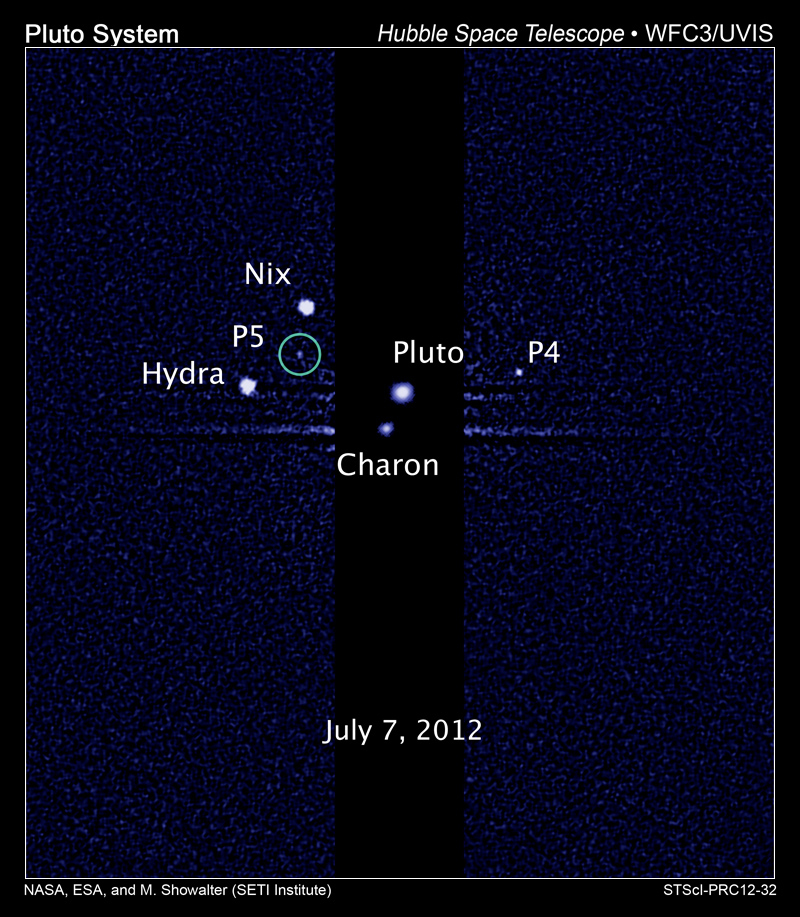Tiny Pluto Moons Should Be Named Vulcan and Cerberus, Discoverers Say

The discoverers of two newfound Pluto moons will officially propose the people's-choice names Vulcan and Cerberus for the tiny objects, according to media reports.
Those monikers were the top two vote-getters in the unofficial "Pluto Rocks" naming contest, which sought out more memorable names for the minuscule Pluto moons P4 (discovered in 2011) and P5 (found last year). Vulcan ran away with the overall title after being endorsed by famed "Star Trek" actor William Shatner.
"We did not feel rigidly bound by the vote totals, but in the end we decided that Vulcan and Cerberus/Kerberos were pretty good names," P4/P5 discovery team leader and "Pluto Rocks" organizer Mark Showalter, of the SETI (Search for Extraterrestrial Intelligence) Institute in Mountain View, Calif., told NBC News' Alan Boyle.
So Showalter and his colleagues are submitting the names to the International Astronomical Union, which traditionally authorizes monikers for celestial bodies. But that doesn't mean that Vulcan and Cerberus are slam dunks, as Boyle and others noted.
For one thing, Vulcan is already the name of a hypothetical mini-planet once proposed to orbit between Mercury and the sun, the scientific journal Nature pointed out. And the name Cerberus is more concretely taken, by a very real asteroid.
This second issue may be solved by proposing the alternate spelling "Kerberos" for the Pluto moon P5, Showalter told Boyle. We'll just have to wait and see.
P4 and P5 were both spotted by NASA's Hubble Space Telescope. They're the smallest of Pluto's five known moons, with P4 estimated to be 8 to 21 miles (13 to 34 kilometers) across and P5 just 6 to 15 miles (10 to 25 km) wide.
Breaking space news, the latest updates on rocket launches, skywatching events and more!
Pluto's largest moon by far is Charon, which at 648 miles (1,043 kilometers) across is nearly half as big as Pluto itself. The dwarf planet's other two known satellites, Nix and Hydra, range between 20 and 70 miles (32 to 113 km) wide.
Hubble discovered all of Pluto's moons except Charon. The space telescope is still scanning Pluto's neighborhood for more moons and debris, to help NASA's New Horizons mission better prepare for its flyby of the dwarf planet in 2015.
Follow Mike Wall on Twitter @michaeldwall and Google+. Follow us @Spacedotcom, Facebook or Google+. Originally published on SPACE.com.

Michael Wall is a Senior Space Writer with Space.com and joined the team in 2010. He primarily covers exoplanets, spaceflight and military space, but has been known to dabble in the space art beat. His book about the search for alien life, "Out There," was published on Nov. 13, 2018. Before becoming a science writer, Michael worked as a herpetologist and wildlife biologist. He has a Ph.D. in evolutionary biology from the University of Sydney, Australia, a bachelor's degree from the University of Arizona, and a graduate certificate in science writing from the University of California, Santa Cruz. To find out what his latest project is, you can follow Michael on Twitter.
